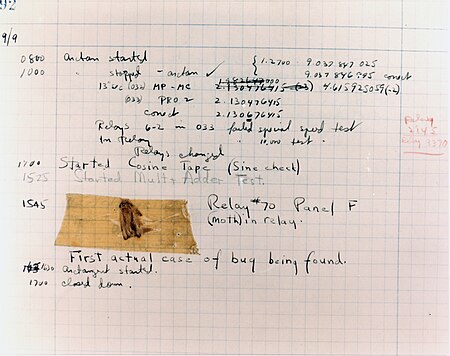Bug (software): Difference between revisions
Pat Palmer (talk | contribs) (bringing the caption into the article) |
Pat Palmer (talk | contribs) mNo edit summary |
||
| Line 1: | Line 1: | ||
{{subpages}} | {{subpages}} | ||
[[File:First_Computer_Bug,_1945.jpg|thumb|right|450px|The word ''bug'' came to be used after an actual insect was found to cause a failure in early, vacuum-tube-based computers.]] | |||
A '''bug''' in software is the misbehavior of a computer program that was not intended by the person(s) who developed it. The word can likewise be used to described unwanted behavior in hardware, including computer chips or any hardware based on digital logic, and in analog hardware designs. | A '''bug''' in software is the misbehavior of a computer program that was not intended by the person(s) who developed it. The word can likewise be used to described unwanted behavior in hardware, including computer chips or any hardware based on digital logic, and in analog hardware designs. | ||
The word ''bug'' came to be used after an actual insect was found to cause a failure in early, vacuum-tube-based computers. The girst such bug was found in 1947 in the Mark II Aiken Relay Calculator while it was being tested at Harvard University. The operators affixed the moth to the computer log, with the entry: "First actual case of bug being found". (The term "debugging" already existed; thus, finding an actual bug was an amusing occurrence.) In 1988, the log, with the moth still taped by the entry, was in the Naval Surface Warfare Center Computer Museum at Dahlgren, Virginia, which erroneously dated it 9 September 1945. The Smithsonian Institute's National Museum of American History and other sources have the correct date of 9 September 1947 (Object ID: 1994.0191.01). The Harvard Mark II computer was not complete until the summer of 1947. | The word ''bug'' came to be used after an actual insect was found to cause a failure in early, vacuum-tube-based computers. The girst such bug was found in 1947 in the Mark II Aiken Relay Calculator while it was being tested at Harvard University. The operators affixed the moth to the computer log, with the entry: "First actual case of bug being found". (The term "debugging" already existed; thus, finding an actual bug was an amusing occurrence.) In 1988, the log, with the moth still taped by the entry, was in the Naval Surface Warfare Center Computer Museum at Dahlgren, Virginia, which erroneously dated it 9 September 1945. The Smithsonian Institute's National Museum of American History and other sources have the correct date of 9 September 1947 (Object ID: 1994.0191.01). The Harvard Mark II computer was not complete until the summer of 1947. | ||
Revision as of 08:42, 5 July 2022
A bug in software is the misbehavior of a computer program that was not intended by the person(s) who developed it. The word can likewise be used to described unwanted behavior in hardware, including computer chips or any hardware based on digital logic, and in analog hardware designs.
The word bug came to be used after an actual insect was found to cause a failure in early, vacuum-tube-based computers. The girst such bug was found in 1947 in the Mark II Aiken Relay Calculator while it was being tested at Harvard University. The operators affixed the moth to the computer log, with the entry: "First actual case of bug being found". (The term "debugging" already existed; thus, finding an actual bug was an amusing occurrence.) In 1988, the log, with the moth still taped by the entry, was in the Naval Surface Warfare Center Computer Museum at Dahlgren, Virginia, which erroneously dated it 9 September 1945. The Smithsonian Institute's National Museum of American History and other sources have the correct date of 9 September 1947 (Object ID: 1994.0191.01). The Harvard Mark II computer was not complete until the summer of 1947.
